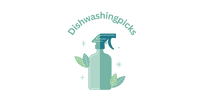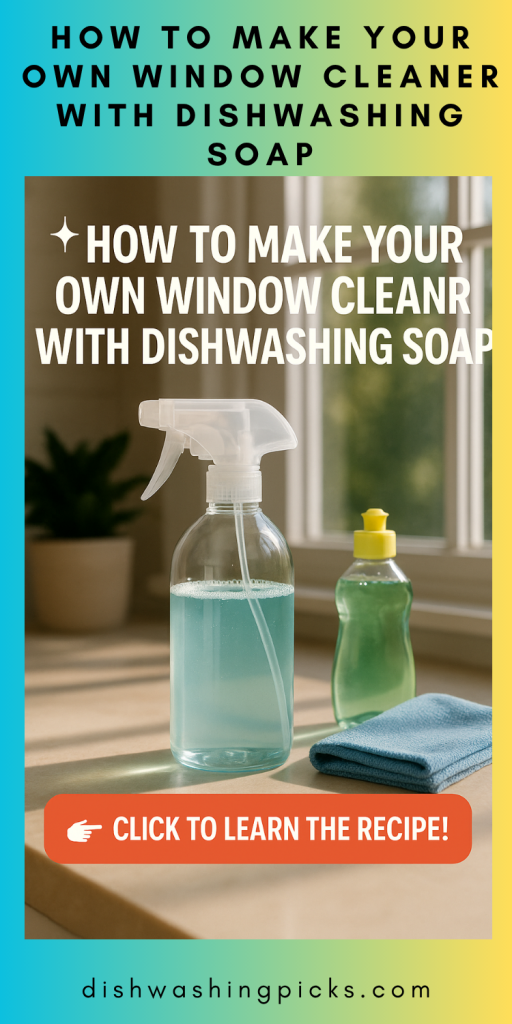Here’s the thing: dishwashing soap isn’t just great for scrubbing last night’s spaghetti mess—it’s kind of a low-key superhero for glass. Why? Because it’s designed to cut through grease. That’s its whole job.
Think about what ends up on your windows: fingerprints, cooking residue if they’re near the kitchen, and all that mysterious gunk that just… appears out of nowhere. Dish soap breaks all of that down without being harsh on the glass.
Another bonus? A tiny bit goes a long way. Use too much, and you’ll end up with sudsy chaos. But use just the right amount, and you get this perfectly smooth cleaner that wipes away grime like it’s nothing.
And unlike some heavy-duty chemical cleaners, dish soap is gentle. You won’t end up coughing on fumes or worrying about what you just sprayed all over the house. It’s as safe as cleaning gets—especially if you have kids or pets running around.
Now that you know why it works, let’s get to the fun part—how to actually make the cleaner.
The Step-by-Step Recipe for DIY Window Cleaner
Alright, here’s where the magic happens. You don’t need a chemistry degree, a lab coat, or even anything fancy—just a few basics you probably already have.
What you’ll need:
- 1 clean spray bottle (reuse an old one if you’ve got it)
- 2 cups of warm water
- A couple of drops of dishwashing soap (seriously, just a couple)
- Optional: a splash of white vinegar for extra shine
How to mix it:
- Start with water. Pour the warm water into your spray bottle first—this helps the soap mix in easily.
- Add the soap. We’re talking drops here, not glugs. Too much soap and you’ll be chasing bubbles instead of cleaning windows.
- Optional vinegar splash. If you want that squeaky-clean, streak-free finish, add about a tablespoon of vinegar. It’s not required, but it’s like giving your cleaner a little upgrade.
- Shake gently. Don’t go full protein-shake mode here—just a light swirl so everything blends without turning into a foamy mess.
And boom—you’ve just made your own window cleaner. No mysterious blue liquid, no strong chemical smell, just something you whipped up in under five minutes.
But of course, making it is just the first step. Up next? How to actually use it so you don’t end up with streaks and smudges everywhere.
The Best Way to Use Your Homemade Cleaner for Perfectly Clear Windows
Okay—you’ve got your magic potion in the spray bottle. Now what? You might think, “Just spray and wipe, right?” Well, yes… but also no. There’s a little technique involved if you want those windows to look crystal clear instead of like they survived a soap storm.
1. Pick the right cloth.
Paper towels? They work, but they can leave lint. Old t-shirts? Great for your car, not so much for glass. The real MVP here is a microfiber cloth—it grabs dirt, doesn’t shed fuzz, and leaves things looking streak-free.
2. Don’t drown the glass.
A few sprays are enough. If you soak the window like you’re trying to water it, you’ll end up with drips and streaks. Light mist, even coverage—that’s the goal.
3. Wipe like you mean it.
Here’s the pro tip: wipe in an S-shape instead of random circles. Why? Circles just move the grime around. The S-shape technique actually lifts the dirt and pushes it away.
4. Buff for extra shine.
Once you’ve wiped, take a dry section of your cloth and give the window a quick buff. This is the step that makes the difference between “pretty clean” and “holy wow, is that even glass anymore?”
And that’s it. Easy, right? You’ve just turned basic dish soap and water into a full-on cleaning upgrade.
But let’s not stop there—because you’re probably wondering: what else can you clean with this same DIY mix?
The Best Way to Use Your Homemade Cleaner for Perfectly Clear Windows
Okay—you’ve got your magic potion in the spray bottle. Now what? You might think, “Just spray and wipe, right?” Well, yes… but also no. There’s a little technique involved if you want those windows to look crystal clear instead of like they survived a soap storm.
1. Pick the right cloth.
Paper towels? They work, but they can leave lint. Old t-shirts? Great for your car, not so much for glass. The real MVP here is a microfiber cloth—it grabs dirt, doesn’t shed fuzz, and leaves things looking streak-free.
2. Don’t drown the glass.
A few sprays are enough. If you soak the window like you’re trying to water it, you’ll end up with drips and streaks. Light mist, even coverage—that’s the goal.
3. Wipe like you mean it.
Here’s the pro tip: wipe in an S-shape instead of random circles. Why? Circles just move the grime around. The S-shape technique actually lifts the dirt and pushes it away.
4. Buff for extra shine.
Once you’ve wiped, take a dry section of your cloth and give the window a quick buff. This is the step that makes the difference between “pretty clean” and “holy wow, is that even glass anymore?”
And that’s it. Easy, right? You’ve just turned basic dish soap and water into a full-on cleaning upgrade.
But let’s not stop there—because you’re probably wondering: what else can you clean with this same DIY mix?
Other Surprising Uses for Your DIY Window Cleaner
Here’s the thing—once you’ve made this little bottle of DIY magic, you’re not limited to just windows. This mix is basically a multi-tasker waiting to impress you.
1. Mirrors that actually look like mirrors.
Ever finish “cleaning” your bathroom mirror only to see streaks the second steam hits it? Your homemade cleaner handles that like a pro. One quick spritz, a wipe with microfiber, and hello, clear reflection.
2. Glass tabletops.
If you have one of those coffee tables where every fingerprint seems to show up five seconds after you wipe it—this is your new best friend.
3. Shower doors.
Soap scum, meet your match. The dish soap in the mix cuts through that cloudy layer on glass shower doors without you needing a full workout to scrub it off.
4. Car windows.
Yep, you can take it outside too. It’s gentle enough for your car’s glass, and unlike some harsh cleaners, it won’t leave residue that turns into glare in the sunlight.
Basically, once you start using this stuff, you’ll find yourself spraying it everywhere—because why stop at windows when you’ve got a cleaner this easy and cheap?
And that brings us to the wrap-up—because now you know how to make it, use it, and even stretch it beyond just windows.
The Conclusion & Final Takeaway
So, there you have it—you’ve officially joined the DIY window cleaner club. No more mystery bottles from the store, no more wondering what those neon-colored chemicals are doing to your house (or your lungs). Instead, you’ve got a simple mix: water + dish soap + maybe a dash of vinegar, and you’re good to go.
The best part? You didn’t just save a few bucks—you also took control. You made something that works just as well (if not better) than store-bought cleaners, and you can tweak it however you like. Want it a little stronger? Add a splash more soap. Want that extra sparkle? A bit more vinegar.
Now picture this: the sun’s coming through your windows, and instead of revealing streaks and smudges, it’s just… clear. Clean. Perfect. And every time you grab that little spray bottle, you’ll remember, “Yep. I made that.”

